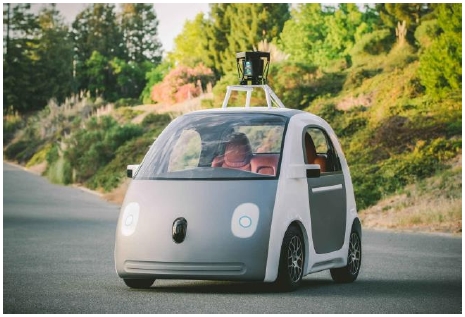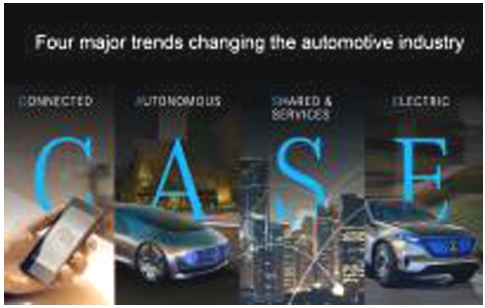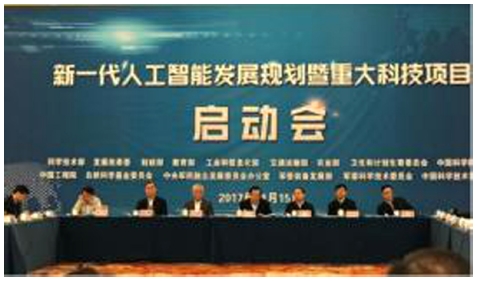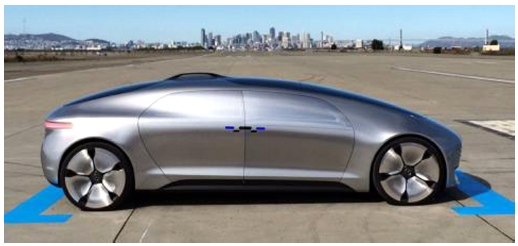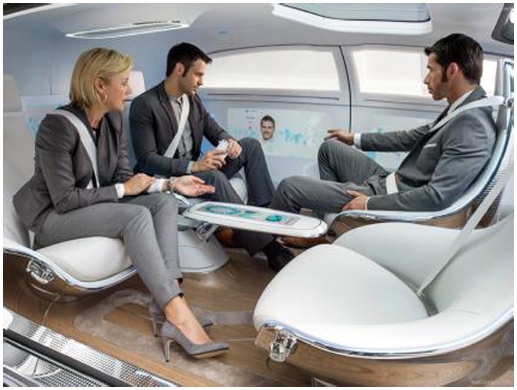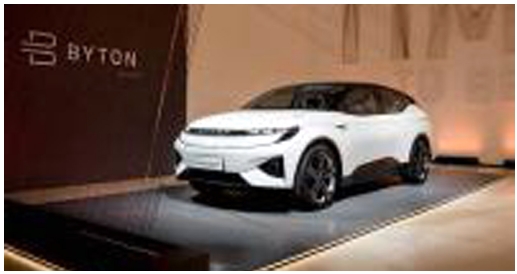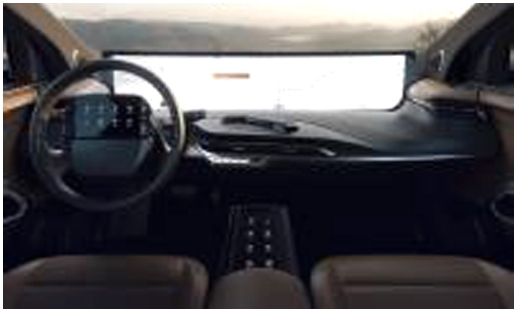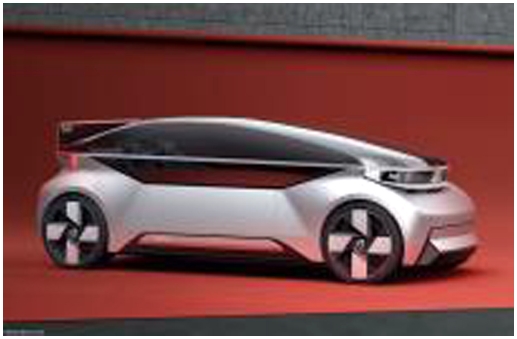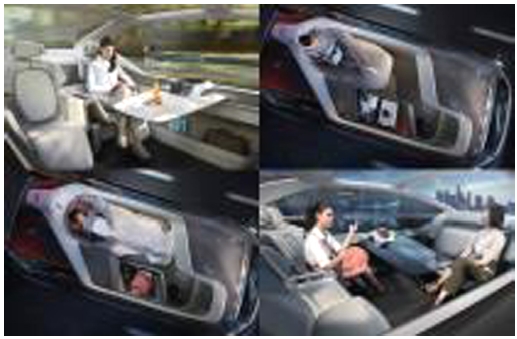
An Observation on Alterations of Usability in Automobile Interior Design with Autonomous Driving Technology Escalation
Copyright Ⓒ 2019 KSAE / 166-03
This is an Open-Access article distributed under the terms of the Creative Commons Attribution Non-Commercial License(http://creativecommons.org/licenses/by-nc/3.0) which permits unrestricted non-commercial use, distribution, and reproduction in any medium provided the original work is properly cited.
Abstract
The purpose of this study is to observe and analyze the characteristics of the significant changes of interior designs in recent mobility by escalation of autonomous technology in order to justify the changes in the automotive interior design usability with mobility and habitability. This study reviews the characteristics by analyzing the recent changes of vehicle designs through the concepts of mobility and habitability with autonomous technology. The objective of this paper is to observe the design attributes of recently unveiled autonomous driving concept cars. The roles of spaces in autonomous vehicles and architecture will be differentiated. An architectural space provides solutions for psychological needs of spiritual relaxation, hygiene, and feeding in living spaces, whereas an autonomous vehicle provides physical relaxation with short sleeping. These have led to the differentiations between conventional automobiles, which are for owning, and the spaces of mobility and architecture, which are for sharing. The paradigm for space and economy will be changed for traditional automobiles, which are driven by humans and owned individually, whereas an architectural space is to be shared in order to accommodate vehicle sharing for individual needs for mobility. Although it could be seen as a contradiction to the perspective of enlarging the sharing economy, traditional automobiles and digital oriented mobility are classified into owning and sharing, whereas urban architectural space is for sharing.
Keywords:
Mobility, Usability, Habitability, Owning, Sharing1. Introduction
1.1 Background and Purpose
As Thomas Piketty dubs that characteristics of the new century begin to appear after 15~20 years later from the calendar dates changed into the century,1) many innovation caused by digital technologies are becoming even more evident in various fields in these days, at the point of 19th year passed from the 21st century began. The time gap between the calendar dates and reality as this were the same even in 100 years ago for the fact that the spreading mass production system between 1915 and 1920 as one of the representative technological features of the last 20th century invented by Henry Ford who set up Ford Motor Co. and developed Model T.2)
As the innovations, digital technology is the most representative phenomenon of 21st century, either the most noticeable changes can be found in both automotive industry and automobile itself. The major change resulted by the transition of viewpoint for the automotive industry as one of fields of heavy industry build transportation machines since the industrialization with mass production method. Already, a change on the point of view for the automobile occurred from the simple hardware to as a software application and communication technology combined IT appliance for the first time with experimenting driverless car prototype in 2009 by Google.
Though the autonomous driving function does not look to be related to exterior and interior design of the vehicles directly, it can be predicted that these changes differentiate vehicle usability, and the usability change of the vehicle can be seen on several recent autonomous driving concept cars.
Therefore, this research purposed to specify major habitability and livability changes through observing recent vehicles which shows developing of autonomous driving technology escalation.
1.2 Scopes
This paper covers concept changes in usability and habitability of mobility with autonomous driving technology escalation. For the research, the cases of Germany and China are reviewed with recent autonomous driving concept cars. And the changes in usability and habitability are finalized with the boundaries as the follows;
Firstly, influences and changes from digital technology and automotive industry
Secondly, usability characteristics on smart mobility
Thirdly, usability in vehicle interiors
2. Outlining Changes
2.1 Digital Technology and Auto-industry
Digital technology introducing to vehicles began from 1980s right after the two times of Oil shocks in 1970s to develop better engines for enhanced gas millage by controlling fuel supply devices and in the other hand enhancing protective safety with better braking systems to meet strengthened safety regulation,3) but in nowadays, it is hardly seen the vehicles without any electronic devices. And it can be predicted that one of the major characteristics of next generation cars would be consumption of huge amount of communication and semi-conductor. This is because of the transition from the traditional industry of manufacturing internal combustion engine vehicle into mobility service industry of having higher portion of usability oriented characteristics.4)
Generally, electric vehicle does not need additional devices such as intake and exhaust systems that internal combustion engine requires with engine main body. And the internal combustion engine can be developed and produced only by specialized companies which have accumulated developing experiences by long term investment for developing capability of many kinds of precise parts which requires extreme durability. But electric motor, as an alternative to internal combustion engine can be produced with simpler theories and technologies, and even more stable and powerful than internal combustion engines. And the knowhow for cultivating vehicle performance is not an important matter either in developing electric vehicle.5)
There are other evidences already in current automotive industry too, as they share many parts developed in same technology by modularization, digitalization, horizontally dividing. Therefore, there are many new comers in nowadays with electric propulsion system as is showing in the recent phenomenon in automotive industry which has been has high barriers traditionally.
2.2 Automotive Industry and Mobility
Automobiles are considered differently to the other industrial products for their multiple values and characters with different preferences created by not only with functional value but also with brand history related body styling. For the reasons, consumers judge automobiles sensitively as favorite products. And with the sensitive value of automobile, consumers feel joy, delight, and happiness during their ride. For this, most of global automotive brands promoted their brand character for this with fun to drive in various speeches until 2010s.
But most of personal automobiles are used for drive only by 4 % of time, which is about 1 hour per day. This figures show quite low operation rate in personal transportations, and for the reasons, it can be predicted the momentum of automotive industry may transfer to mobility service with car sharing business by floating sharing economy and it would become even more popular.6)
The term of mobility usually denotes types of consumer vehicles for sharing or rent, not for owning them. And as the mobility in this case, it is provided with service concept, and consumers care for service brand more provide sharing or car managing service than automobile manufacturing brands.3) This can be understood as the same context in travellers select their airline brand for providing flight services than the type of aircraft or aircraft manufacturer brands.
2.3 Smart Mobility and Service
Progressing sharing economy, the flowing changes are combined to information technology, the concept of usership would be set at the center rather than ownership, and the vehicle for usership driven by information technology can be classified as smart mobility.7)
With the concepts, vehicles can be noted as the term of MaaS(Mobility as a Service).8) Originally, Maas does not limited to automobiles only; it includes overall transportation service for people to provide service such as subway, taxi, bus, train, all are not for owning.9)
The most of current automobile manufacturers are getting profits by selling hardware called automobile however, the managing company or individual participant to Maas may get profits by working for services. But the concept of service can be applied to various fields, even any participant, not only vehicle manufacturer, can access to the service market.10)
Another similar term as this is TaaS(Transportation as a Service), which has same meaning as the variet and types of mobility.
Nevertheless, there would be also some opinions for the consumers who buy traditional automobile as one of collections even though in the age of autonomous driving and car sharing.11)
2.4 Mobility Concept Cases
Daimler in Germany presented their mid-to long-term technology strategy called CASE in Paris Motor Show in September 2016. The CASE of Daimler has same directions as in the main four trends of technologies to current major global automotive companies.
C is for connected, which means smartness with connected. It is summarized to concept to connect automobile to various products with the background of progression of IoT and cloud technology evolution, which enhances speed and capacity of communication.
A is for autonomous, means automated driving. It pursues realizing safe autonomous vehicle by reducing mistakes of human driving.
S is for shared & services, which looks out to be spread ride sharing and car sharing with the background of view change for value from owning to sharing.
E is for electrifying. Electric powered and plugged hybrid vehicles both are now provided with technological advancement and politic demand for eco-friendliness.12)
TESLA aims similar direction as these concepts which have been propelled developing electric vehicles with purpose to set up eco-friendly energy system, also Google has been propelled autonomous for the purpose to make easy and convenient world. UBER and LIFT has been created flow of service and sharing for the purpose to reform designs of cities.
Amazon is trying to connect smart home and smart car with the technology called Alexa deployed by user voice speech recognition interface.
These are basically same as the CASE by Daimler though, it might be looked to automotive industry scale-down in the narrow meaning of machinery industry, however if the CASE concept is actualized, the automotive industry can have even wider range and broad meaning by including digital technology.
In other words, if the technological fields such as automobile, information, electric and electronics get together into a mega-scale industry by mixing up, added service and related near industries, and it’s not too much to say the automotive industry includes all kinds of industries.
China, the world no.1 nation in annual automobile manufacturing volume since 2006 declared national strategy to concentrate to electric vehicle developing in order to actualize automobile strong nation rather than a great automobile nation with grasping their less competence to automotive companies in America, Europe, and Japan in traditional internal combustion engine vehicles. More than 60 electric powered vehicle manufacturers got on the stage with the support of Chinese government under the strategy.
Additionally, China is showing some momentums to develop world best artificial intelligent flat form on 15th of January 2017, and the government declared they will become world best advanced nation in the field of artificial intelligent with the project claimed to develop ‘National new generation artificial intelligent open innovative flatform (國家新一代人工知能\開放昌新平臺)’ by the year 2030.13) The flat form does not limited to automobile only, and it might be noticeable for further developing phases on the view point for the national leading developing with which totalize all industry fields for their future initiative.
3. Observing Concept Cars
3.1 Autonomous Driving Concept Car F-015
Mercedes Benz presented an autonomous driving concept car F-015 at the Consumer Electronics appliance Show held in Las Vegas USA in 2015. It was reviewed for providing a moment of changes after 130 years of automotive industry history by presenting the first electric powered autonomous concept car F-015 from traditional automobile company.14)
The concept car has individual turning around seats for 4 persons, at the interior space in which passengers can retrieve information or holding video conference, enjoying entertainment through OLED screens deployed on door trims and side glass areas.
3.2 Autonomous Driving Concept Car FMC BYTON
At the CES 2018, FMC(Future Mobility Corporation) BYTON, a Chinese new electric vehicle brand started up in 2016 appeared on the stage. The company set up newly by former executives of TESLA, BMW, Nissan presented a SUV type concept car named 「SIV」. The 「SIV」 can be driven either selectively with full autonomous or human driving mode, and instrument panel has big portion in interior design for the concept.
The instrument panel was designed with information accessible concept with ultra-big touch screen of 1.25 m wide, and 0.25 m height. The total appearance of the interior design is quite compromised one than other autonomous driving concept cars. The BYTON was reviewed with the model from media for good branding even considering a Chinese manufacturer.15)
3.3 Autonomous Driving Concept Car Volvo 360c
Volvo 360c autonomous driving concept car presented in 2018 shows more individualized autonomous vehicle usages. It is a perfect autonomous driving mobility which can be called up and ridden by mobile phone calling application of user. It shows selective usage concepts by user requesting for living, office, party, and sleep.
The selected type vehicle is approaching automatically to the user, and drives whole route to the final destination with fully autonomous driving. Volvo explains the concept car 360 c can replace aircraft long distance trip, considering the whole time to require for both check-in process and additional first and last trips to and fro airport.16)
However, for it premises a perfect autonomous driving, the 360 c is not for near future.17)
4. Synthesis of Change
4.1 Mobility and Usability
The cases of autonomous driving concept cars which have been reviewed shows possibilities of future automobile as well as transportation service called as mobility of changing into a part of industry. The flowing enables estimating change for an automobile as a product to be transformed in usability as mobility rather than owning.
In fact, automobiles have been developed as representative personal consumer products from ever the first invention to present. This aspect make aesthetics, fashion trend or the reflecting consumer preferences works as the most important factors in developing new automobile.
Michiaki mentioned automobiles have spiritual values, and it symbolizes a social position to somebody, either means of expressing presence or lifestyle to others.3) With this context, aesthetics has been having much portion on body styling design so far even in age of developing commercial vehicles or public transportations.
However, fully autonomous vehicle like Mercedes Benz F-015, Volvo 360 c have to be considered as a type of mobility concept rather than an automobile. The concept of vehicle seems to be changed from current vehicle driven by human driving which provides safe driving environment with hardware to driver and passengers got into spending time for the passengers properly at the interior space of autonomous car which does not have steering wheel and pedals.
Therefore the claim is convincing that the future automobile manufacture or mobility service-company might not be a current automobile manufacture or hardware developing company.3)
Basically, automobiles have potential in space enough to provide livability to human. For this, it can accommodate both inert body status such as sleeping, as well as meditation status. Therefore architectural space of city provides space service for accommodating people who needs physiological facility and activity. And automobiles with living function provide space service to keep inert body status.4)
With this context, autonomous vehicle closely combined to city in mobility function, one of which is combination to urban spaces. In case of change of autonomous car from mobility device to living device, the concept of culture of architecture and economy might be changed by combining to the city. And autonomous vehicle should have intuitive and easy controllability regardless of driving skill of passenger.18)
If automobile changed to living device from mobility device, the automobile enables people go places they want during the stay in the car with having time for rest, sleep, entertainment and interact people might have more needs for trip.4)
Considering these factors, accessibility to urban areas and needs for short distance mobility requires different concept from the current automobile developing in automotive industry. That is because of the differences in frequencies, methods, and distances for the conventional vehicles used, as well as for the relationships to the structure of the city in which the vehicle used.19)
The table-01 shows the result of comparisons among the concept cars with the criterion. It can be seen the item of livability became stronger at autonomous vehicle Volvo 360 c.
4.2 Design Characters of Autonomous Car
There are some possibilities in autonomous vehicle concept which has been reviewed in this paper, the role change of traditional automobile from transportation mean to other space to moving device by newly translated role of mobility.
However the value for shape in exterior and interior design of automobile is now gradually become low by introducing digital technology. The main reasons for the less importance on shapes are caused by changes in way of consuming products. Shape quality has been have importance portion for a long time as one of influencing factors for consumers to select the 3rd industry products at shops.
The portion for shapes of product appearance is reducing rapidly under the 4th industry environment on autonomous smart products of today. And this viewpoint means the change will occur from the result of developing of automobile by usability forward.
Another noticeable new intelligent area beyond the domain of shape esthetic is representative domain of emotion. Different from the shape emotion which can be expressed in product design developing experience of designers, representative emotion needs perceptual knowledge for there are not visual sign.
The table 02 shows comparisons differences in usability characteristics among traditional vehicles, mobility for sharing service, and fully autonomous driving vehicles. The common parts of these three types of transportation mean are that there are not facilities to meet physiological needs of passengers, and the needs can be solved in architectures in cities.
4.3 Changes in Automotive Design and Usability
The variety of automobile can be actualized with presenting new design based on technological advancement, and it is kept typical types until the next step innovation actualized. Building with developing new types of automobile considering overall design change which is typical types are keep in production.
However, similar context to which had been reviewed, 93 % of automobiles from the total is just parked, 98 % of electronic appliances are in sleeping, 99 % of books are just inserted in bookshelves, and 4 from 5 of architectural spaces are empty. Connections between things and things, between things and human and between space and human, between human and human, between space and thing enable to escape inevitable isolations of things in urban environments.5)
The roles will be assigned if the connection between minimum space of autonomous vehicle and architectural space completed. In other words, architectural space provides solutions for psychological needs of spiritual relax, hygiene, feeding with living spaces, whereas autonomous vehicle provides physical relax with short sleeping. And it can be predicted as the traditional automobile will exist for personal needs for owning in the future. For the context, overall changes are actualized as the vehicles are owned while architectures are shared to accommodate mobility which is to meet individual needs for moving.
5. Conclusion
The directions of changes of usability on future vehicles could have been traced through analyzing characters of recent autonomous driving and mobility technology as well as recent autonomous concept cars. If autonomous vehicles combined with minimum space and architectural space, solutions can be provided as architectural space provides for psychological needs of spiritual relax, hygiene, feeding with living spaces, whereas autonomous vehicle provides physical relax with short sleeping.
With this context, the paradigm for space and economy will be changed for traditional automobile which should be driven by human is owned individually, architectural space is to be shared to accommodate sharing vehicle for individual needs for mobility.
However, on the view of mobility would have more portion in the future for short distance moving, but there could be some contradiction on the conclusion of traditional automobile will exist as a product for personal needs for owning and architectural spaces are shared to accommodate mobility for individual move.
However, it would not be changed the traditional characteristics of individuality of automobile even in the circumstances of sharing economy. Therefore a new type of mobility and traditional automobiles are classified into owning and sharing each and architectural space in city would be worked to accommodate sharing concept vehicles.
References
-
T. Piketty, CAPITAL in the Twenty-First Century, Harvard University Press, London, (2014).
[https://doi.org/10.4159/9780674369542]

- H. Ford, My life and Work, Garden City, New York, (1922).
- B. J. Chang, New Edition Automotive Engineering, Dongmyungsa, Seoul, p44-49, (1997).
- T. Michiaki, 2022 Nenno Jisedaijidousha Sangyo, Hansmedia, Seoul, (2018).
- T. Y. Cho, Design Human, Culture Code, Seoul, (2019).
- UC Berkely, 2016
- N. Lukas, Smart Cities, Smart Mobility, Matador, Leicestershire, (2017).
- https://maas-alliance.eu, , 2019.
- Frost & Sullivan, 2018.
- https://maas-alliance.eu, , 2019.
- https://www.Global-autonews.com, , 2019.
- https://www.daimler.com, , 2016.
- https://www.radiichina.com/is-china-leading-the-race-towards-mass-use-of-self-driving-cars, , 2019.
- https://www.usatoday.com/story/tech/2015/03/18/mercedes-benz-f015, , 2019.
- https://spectrum.ieee.org/cars-that-think/transportation/advanced-cars/ces-2018-chinese-startup-byton-unveils-45000-gadgetpacked-electric-suv, , 2019.
- https://www.volvocars.com, , 2018.
- https://www.mk.co.kr/news/society/view/2018/02/89390, , 2019.
- H. J. Kim, and E. C. Jung, “A Design Concept Proposal of Control UI Which Can Cope with Road Situation by Passenger's Intuition in Self-Driving Environment”, KSAE Fall Conference Proceedings, p1422-1429, (2017).
- T. Smetana, “eMobility-Technology Trend or Paradigm Change?”, KSAE17-W0002, p9-35, (2017).

